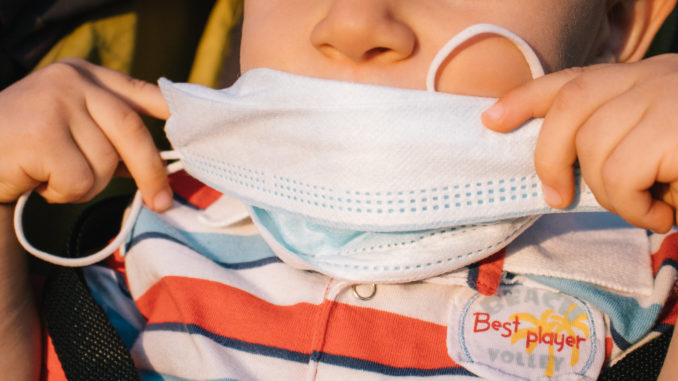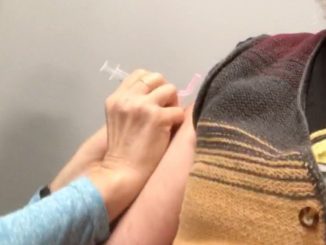
This story is produced by the award-winning journalism nonprofit Capital & Main and co-published here with permission.
The setting was midtown Sacramento, but the scene is going to become familiar across California in the coming weeks. As a harried parent ushered his three children into the grocery store, he stopped to read the printed guidance that had been taped to the entrance: “FOR THOSE WHO HAVE BEEN FULLY VACCINATED, MASKS ARE OPTIONAL.”
Inside the busy market, perhaps one in five adults was masked. The man studied the situation for a moment, then backed his kids out of the store even though they had masks of their own. When asked why he was leaving, the parent replied, “That many people without masks — no way.”
According to the California Department of Public Health, nearly 15 percent of the state’s population “remains without the option for vaccination,” leaving them vulnerable both to those who currently carry COVID-19 and to worrisome new strains of the virus, particularly the highly transmissible Delta variant. That group, more than 5.9 million strong, is composed of kids under age 12—and in California’s rush to reopen, they remain on the outside looking in.
On June 15, Gov. Gavin Newsom declared that the state was officially scrapping its Blueprint for a Safer Economy, and with it the color-coded tier system that had dictated safety measures and business precautions to be taken in each of the state’s 58 counties. Newsom did so despite the fact that 34 of those counties, or 58.6 percent, were still designated as having moderate or worse rates of COVID transmission at the time of his announcement.
Now, if you’re fully vaccinated, you are essentially free to roam maskless around the state. Private businesses may still require that customers wear masks, and CDPH says everyone must mask up inside healthcare facilities and K-12 schools, on public transit and in a few other instances.
But the state’s residents are on the honor system when it comes to whether they’ve met the vaccination threshold for going without a mask. And parents, especially those who cannot afford child care and need to bring their kids with them for essential tasks like food shopping, may then face the possibility of putting those children into situations where their exposure to risk is quite real.
“Children under 12 should be masking whenever they’re not able to social distance around people outside, or whenever they’re inside,” Dean Blumberg, chief of pediatric infectious diseases at UC Davis Health, said recently. With the state throwing open the doors of business and asking people to vouch for their own vaccinations, young people and their parents may find such safe distancing a challenge.
Kids are infected by COVID at lower rates than adults, and their confirmed cases often involve no observable symptoms and appear to run a mild course, experts say. Still, in its most recent update last week, the American Academy of Pediatrics noted that 19 percent of the newest reported COVID cases involved children, an uptick considering that they account for only 14 percent of U.S. cases overall since the pandemic hit. (What constitutes a “child” case of the virus can vary by age ranges in different states.)
This may become a greater factor as summer rolls into fall. Dr. Scott Gottlieb, former commissioner of the Food and Drug Administration, predicted on Monday that kids will become vectors of the newer strains of COVID, particularly when the school year begins.
“The old assumptions about children, and children [not] driving community spread, were based on the original strain of this virus,” Gottlieb told CNBC. “With these new, more contagious variants, I think we’re going to see that children and schools do become more of a focal point of spread.”
While several trials are already underway on COVID vaccines that may be suitable for those age 11 and younger, it’s not clear how quickly the FDA would authorize their emergency use. Beyond that, a number of experts are urging a go slow approach to any such vaccine for kids, especially given the development of myocarditis, an inflammation of the heart muscle, in dozens of cases of younger people after they received the second dose of the Pfizer-BioNTech vaccine.
In the meantime, those under 12 constitute the largest group of completely unvaccinated people in California. And those most likely to be in large crowds and potentially exposed to the virus, health workers say, are those from the same lower income families that already have suffered COVID-related illness and death in disproportionate numbers. They are the families that can least afford to pay for child care, and therefore the most likely to be taking their kids with them on essential trips, often into crowded situations.
The kids at the grocery store are supposed to mask up. The adults? If they say they’ve been vaccinated, they’re under no such obligation.
When Newsom discussed in April the state returning to business as usual two months hence, he noted that residents would still be subject to “ongoing mask-wearing and ongoing vigilance.” In the end, his order lifting the tiered system of guidance essentially removed masking for fully vaccinated people entirely. Only in the most unsafe settings—hospitals, city buses, etc.—is any such rule in place. And with Newsom opposed to a vaccine passport, the idea of “fully vaccinated” itself is really but a suggestion.
Back in Sacramento, the father of three, who asked that his family name not be used, said he’d run into this scenario more than once since the school year ended: Short on time, needing to shop, he gathered all three kids and headed out, only to back off when he saw the crowds and the number of unmasked adults. “It’s a drag,” he said. It won’t change anytime soon.
Copyright 2021 Capital & Main




Be the first to comment